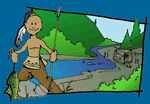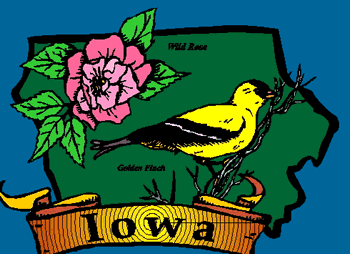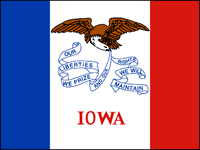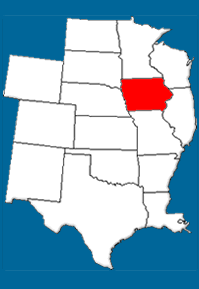


Geography and Landforms:
Iowa is bordered by Minnesota on the north and by Missouri in the south. On the eastern border lie Wisconsin and Illinois, and South Dakota and Nebraska are on the west. The highest point in Iowa is on a farm in Osceola County and is 1,670 feet above sea level. Major rivers include the Mississippi, the Missouri, the Iowa, the Des Moines and the Cedar Rivers.
|
 History:
The first non-native people to reach Iowa were probably French explorers who were canoeing down the Mississippi River around 1673. Others began to make expeditions in the land surrounding the Mississippi, and in 1682, Robert Cavelier claimed the entire region for France, naming it Louisiana in honor of King Louis. After that time, relatively few Europeans ventured as far as what is now Iowa. Those who did were probably fur traders traveling through the area. In 1788 a French-Canadian named Julien Dubuque became the state's first white settler when he bought land from the Meskwaki people to mine lead. The present day city of Dubuque is named for him and is near that first settlement.
|
 Economy:
Iowa's fertile soil makes the production of grain, particularly, corn a central part of the state's economy. Hay and oats are also major crops. Corn grown in Iowa is used to feed livestock, making cattle and pig production another important element of the economy. In 1997, Iowa led the nation in the production of corn, soybeans, hogs, and pigs, and ranked in the top ten states in the raising of cattle. Today, Iowa's farm income ranks second in the U.S.
|
 First Inhabitants:
Paleo-Indians living between 9500 and 7500 BC probably traveled through Iowa hunting various animals including some - like the mammoth, mastodon and giant bison - that are now extinct. However, there is no documented site of a permanent settlement of these people in the area we now call Iowa. By the early Archaic Period (7500--5500 BC), however, there is evidence that small numbers of people lived in Iowa, at least on a seasonal basis. There is evidence of artifacts like spear points and serrated and beveled blade edges. Populations increased through the late Archaic Period (2500--500 BC) and there is evidence of burial sites and more permanent settlements.
|
Books Related To IowaBeetles Lightly Toasted - NA Corporate Author The Book of Story Beginnings - Kristin Kladstrup H is for Hawkeye: An Iowa Alphabet - Patricia Pierce The Luck of the Buttons - Anne Ylvisaker Mary Ingalls on Her Own - Elizabeth Cody Kimmel Orphan - John Weber Sliding into Home - Dori Hillestad Butler Squashed - Joan Bauer Stranded - J.T. Dutton Switcharound - Lois Lowry Tomas and the Library Lady - Pat Mora |
Famous Citizens:
|
| Capital: | Des Moines |
| Entered Union: | December 28, 1846 |
| Population: | 3,107,126 |
| Area | 56,272 |
| Bird | Eastern Goldfinch |
| Flower | Wild Prairie Rose |
| Nickname: | Hawkeye State |
| Governor | Terry Branstad |
Places to Visit in Iowa: (Click the links to learn more.)
|



